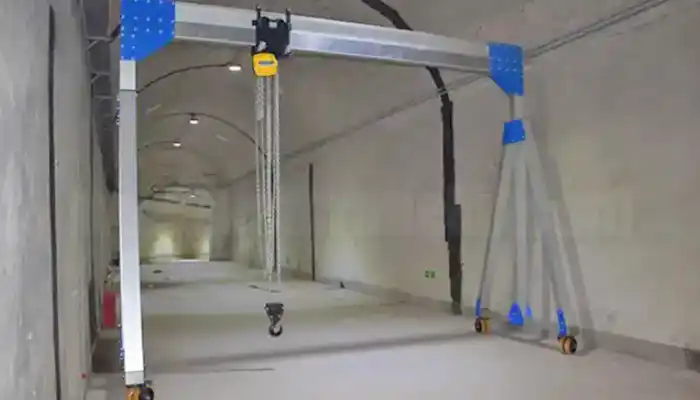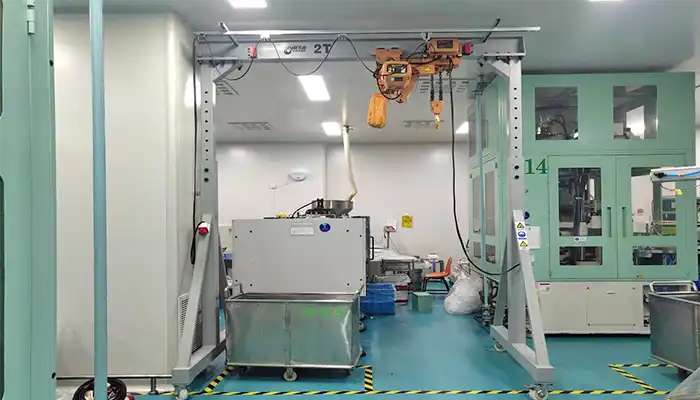
Affordable 2 Ton Gantry Cranes – Smart Buyer Tips
What is a 2 Ton Gantry Crane?
A 2 ton gantry crane is a small-to-medium lifting solution designed for workshops, small factories, and warehouses. It helps move heavy items like machinery parts, steel bundles, or materials across a workspace safely and efficiently. These cranes are often portable or semi-permanent, making them ideal when space is limited.
Why Affordability Isn't the Only Factor
It's tempting to go for the cheapest crane, but price alone doesn't tell the full story. A crane must also be reliable, safe, and durable. Otherwise, unexpected repairs, downtime, or accidents can quickly erase any savings.
- Low initial cost may hide high maintenance needs.
- Overpriced models may include features you'll never use.
- A good balance ensures you get a crane that works consistently without breaking the bank.
Purpose of This Guide
This guide is here to help buyers make informed and practical decisions. By the end, you'll know:
- What to look for in a 2 ton gantry crane.
- How to weigh price against safety and reliability.
- Which features really matter in everyday use.

2 ton steel gantry crane for sale
Overview of 2 Ton Gantry Cranes
A 2 ton gantry crane is a compact lifting solution designed to handle loads up to 2 tons efficiently. It's lightweight, easy to move, and ideal for workshops, small factories, and warehouses. These cranes provide a practical way to lift, transport, or position materials without needing a permanent overhead system.
Common Designs:
- Steel gantry crane: Durable and strong, suitable for indoor or outdoor use with moderate-to-heavy lifting cycles.
- Aluminum gantry crane: Lightweight and portable, perfect for small workshops or locations where mobility is a priority.
- Small rail-traveling gantry crane: Moves along a fixed rail system for precise positioning in a defined workspace.
Each design has specific advantages. Steel cranes are robust but heavier. Aluminum cranes are easier to reposition but may have lower long-term load endurance. Rail-traveling cranes offer repeatable movement in compact spaces.
Determining Your Lifting Needs
Before buying a 2 ton gantry crane, it's important to understand exactly what you need to lift, how often, and under what conditions. Getting this right upfront prevents overspending and ensures safe operations.
1. Load Considerations
Understanding your load requirements is key to choosing the right crane. Consider maximum weight, frequency, and duty cycles.
- Maximum Weight per Lift: Always check the heaviest load you plan to lift. Never exceed the crane's 2-ton limit to avoid safety hazards and equipment damage.
- Frequency of Lifts: How often will the crane be used each day? Frequent lifts require a durable hoist and trolley system to handle wear.
- Duty Cycles: Determine if your operations are occasional, moderate, or heavy use. This affects whether a standard crane or heavy-duty model is needed.
Properly evaluating these ensures you don't overspend on features you don't need or end up with a crane that can't handle your workload.
2. Workspace and Headroom
The physical space where the crane will operate affects type and design. Consider indoor/outdoor conditions and headroom limits.
- Indoor vs Outdoor Use: Indoor cranes can be lighter and simpler, while outdoor cranes may need weatherproof coatings, stronger frames, and robust safety features.
- Ceiling Height or Runway Restrictions: Low ceilings or limited headroom may require a telescoping or low-profile gantry crane. Ensure enough clearance for the crane and hoist to operate safely.
Accurately measuring your workspace helps prevent installation issues and ensures smooth operation.
3. Mobility Needs
How and where you plan to move the crane influences your choice between stationary and portable models.
- Stationary vs Portable Gantry Cranes: Stationary cranes are fixed in place for consistent lifting zones. Portable cranes can move across workshops or storage yards for flexible operations.
- Manual vs Electric Movement: Manual movement is cost-effective and works for occasional tasks. Electric movement is faster, reduces physical strain, and is better for frequent use in larger spaces.
Matching mobility needs with the right crane design maximizes efficiency while keeping costs reasonable.
Tips for Finding an Affordable 2 Ton Gantry Crane
Buying a 2 ton gantry crane doesn't have to break the budget. The key is to focus on options that offer good quality, durability, and long-term value. Here are some practical tips for smart buyers:
- Compare Local vs International Suppliers: Local suppliers are easier to inspect and maintain. International suppliers may offer lower prices but consider shipping, duties, and spare parts.
- Standardized Designs vs Customization: Standard models like L-frame or A-frame cranes are cheaper and quicker to get. Only opt for custom designs if truly needed.
- Consider Used or Refurbished Cranes: Well-maintained second-hand cranes can save money, but check hoists, trolleys, wheels, and safety features carefully.
- Factor in Long-Term Maintenance Costs: Think beyond the initial price. Spare parts, repairs, and servicing add up over time.
- Choose Certified Manufacturers: CE or ISO-certified cranes ensure safety and quality, giving peace of mind for long-term use.
Focusing on these points helps you balance price with performance and safety. A smart purchase means getting a crane that works efficiently now and won't cost extra in downtime or repairs later.

2 ton telesoping gantry crane for sale
Optional Features to Watch
Even for a 2 ton gantry crane, certain optional features can make your work easier, safer, and more efficient. While these upgrades may add some cost, they can pay off in long-term convenience and reduced downtime.
- Telescoping Legs: Adjustable height allows you to lift different sized loads and work in low-headroom areas.
- Electric Hoist and Trolley: Speeds up lifting and reduces manual effort, making repeated operations easier.
- Weatherproof or Corrosion-Resistant Coatings: Essential for outdoor use to protect the crane from rust and extend its life.
- Safety Features: Limit switches, emergency stops, and overload protection prevent accidents and damage.
Choosing the right combination of these features ensures the crane fits your specific workflow and environment. They may not all be necessary, but even a few can improve efficiency, safety, and overall value.
Red Flags for Smart Buyers
When shopping for a 2 ton gantry crane, it's just as important to know what to avoid as what to look for. Some warning signs can help you steer clear of bad purchases that could cost more in the long run.
- Extremely Low Prices: If a deal seems too good to be true, it probably is. Cheap cranes may compromise build quality or safety.
- Lack of Documentation or Certifications: Absence of CE, ISO, or other standard certificates can indicate unreliable manufacturing practices.
- No After-Sales Service or Spare Parts: A crane without support can lead to costly downtime if something breaks.
- Suppliers Unwilling to Share Technical Specs: Transparency is key. If a supplier avoids giving specifications, it's a major red flag.
Being aware of these red flags helps you avoid costly mistakes and ensures you invest in a crane that is safe, reliable, and supported over time.
Practical Buying Checklist
Before making a purchase, having a clear checklist can save time, money, and headaches. A systematic approach helps ensure the crane you choose fits your needs and budget.
- Define Load Requirements and Working Environment: Know the maximum load, lifting frequency, and whether the crane will be used indoors, outdoors, or in tight spaces.
- Compare Multiple Quotes and Specifications: Look at price, build quality, components, and included features to make an informed choice.
- Verify Manufacturer Reputation and References: Check reviews, certifications, and past customer feedback to ensure reliability.
- Ensure Installation and Maintenance Support: Confirm the supplier provides proper installation guidance and after-sales service.
- Consider Optional Upgrades Based on Future Needs: Think ahead—features like telescoping legs or electric hoists may save effort as your operations grow.
Conclusion
Buying an affordable 2 ton gantry crane doesn't have to mean sacrificing safety, reliability, or performance. With careful evaluation, you can find a crane that meets your operational needs while staying within budget.
- Recap: Affordable cranes can be safe and reliable if you focus on quality components and certified suppliers.
- Evaluate Carefully: Look at features, manufacturer credibility, after-sales support, and total cost of ownership—not just the price.
- Call-to-Action: Reach out to Yuantai Crane (or your preferred supplier) for a personalized quotation tailored to your workshop or warehouse needs.